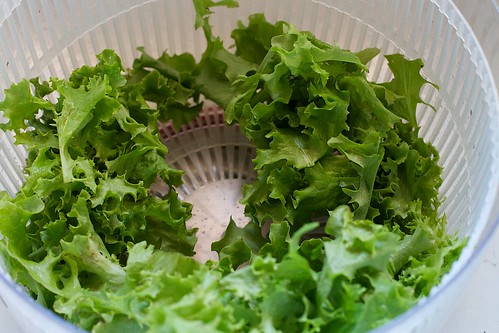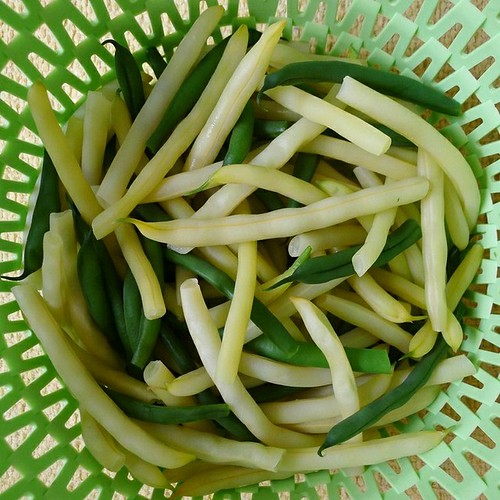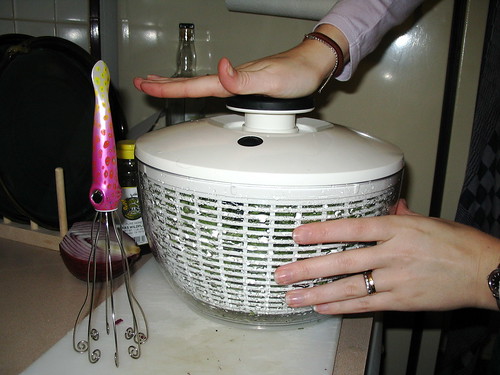Choosing & Using a Salad Spinner
This post contains a few affiliate links for products, such as the salad spinner, selected from Amazon’s catalog. We receive a small commission if you buy. (P.s. It helps pay the hosting bill.)
What tools is your kitchen missing that you can’t live without?
I personally have a ton of gadgets. But going through those gadgets and choosing the best can be quite the chore. I’ve been working on a series of article recommending different kitchen and cooking tools. I’ve made it my mission to explore the use of kitchen tools and help cooks, newbie and veteran alike, learn which tools work best for them.
Today, we’re going to learn about using (and loving!) the salad spinner.

A salad spinner is the easiest and quickest way to wash and dry greens in salad, but it’s capable of handling much more than that.
Blueberries, broccoli, and other fresh produce from the grocery or farmer’s market are also easily cleaned with this tool without leaving excess water.
If you’re not familiar with the tool, a salad spinner is a plastic bowl with a removable plastic strainer and special top. Once closed and set into motion, it spins the strainer inside the bowl. But there’s still more to it than just that.
If you’re a salad-lover, you’re probably aware of how annoying it can be to both wash and dry the greens for your creation. Maybe you’ve been patting them dry using paper towels, but you know it’s unsustainable. The salad spinner solves this problem forever. Just use it once and you’ll realize that it’s indispensable as a kitchen tool. Your salad spinner can rinse away residual dirt and even traces of other contaminants away and then dry them in just a few minutes.
Let’s see how easy it is to handle the salad spinner.
- First put the strainer basket in the salad spinner bowl and put the veggies or fruits you need to wash inside it.
- Add enough water so that you can rinse contaminants free. (If you use a veggie cleaner spray, do this under the sink and rinse with water.)
- Remove the strainer from the salad bowl to drain off the water.
- Rinse clean again with new water, if you so desire!
If you’re a bit obsessive like me, you can always repeat these steps to ensure your fruits and veggies are totally clean.
It’s so easy a child with a step stool can do it!!
Once you’ve washed the produce clean, it’s time to return the strainer and produce back to the bowl.
Put the top back on and use the button or crank to give it a good spin. (In needed, you can open the top to see if you’re happy with how dry your produce is!)
Choosing a Salad Spinner
There are a lot of salad spinners on the market, and it’s best to find the right model to meet your own needs.
In general, when you choose a spinner, make sure the plastic is sturdy, not flimsy. The lid should seal tightly and the compnents should spin freely. Make sure the salad spinner has a thick, sturdy base that won’t tip over if you’re spinning a lot of produce. It should be large enough to hold, wash and dry greens for entire family if you’re cooking for more than one person.
If you’re a busy person, make sure it’s easy to clean. This means that you may want to be able to put it on the top rack of the dishwasher. Salad spinners come in different shapes and sizes, which means you should try to get the smallest one suitable if you need more space in your kitchen.
All spinners operate with similar technology. Some of them have knob-lids, cranks, or even a push-button mechanism for manual spinning. If you have a disability or limited mobility, I recommend the push-button top.
The push-button top models works through a pump action. This is my favorite, especially because I am recently recovering from a shoulder injury. Press down on the button to start the pump action. Let it spin until it stops or push it again to continue drying produce.
Pump button salad spinners usually have a stop button on the lid as well.
They’re easy to control and have a short learning curve.
A salad spinner can be used to store salad in the refrigerator, but this is not recommended.
One of the biggest problems is sanitation. In the fridge, moisture (even though the salad is no longer wet) can re-settle in the salad leaves. If the lid isn’t airtight, icky bacteria, molds etc, can find their way in. Nobody wants that!
Storing Veggies and Fruits from the Salad Spinner
Instead of storing your salad in the spinner, invest in some good, airtight containers built for storing fresh fruits and vegetables. Your final product will keep longer and you’ll be happier for it!
Our editor recommends the following three storage containers. BONUS: Super Affordable!
- Salad Bowl to Go with Locking Lids


- Progressive Prepworks Collapsible Produce Keepers


- Sistema Klip It Collection Lettuce Crisper Food Storage Container


Top featured image credit: Tomatoes and Friends, via Creative Commons license on Flickr





Leave a Reply
You must be logged in to post a comment.